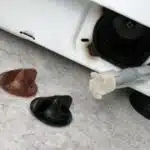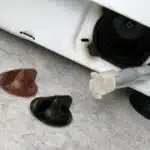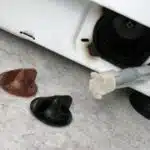Washing machines have become an essential household appliance for many people around the world. They provide convenience and ease in cleaning clothes, bedding, and other fabrics. However, like any other machine, washing machines may encounter problems that require repair or maintenance. One common issue is a malfunctioning agitator, which can cause the machine to make strange noises or fail to clean clothes properly. As a washing machine repair expert, I will guide you through the steps of removing the agitator from your washing machine.
Removing the agitator may appear to be a daunting task for those who have little experience with washing machines. However, with proper guidance and tools, this can be accomplished without much difficulty. In this article, we will cover some basic steps on how to remove the agitator from your washing machine. By following these steps carefully and correctly, you can save money by avoiding costly repairs or even purchasing a new washing machine altogether. So put on your DIY hat and let’s dive into the world of repairing your own washing machine!
Identifying The Issue With Your Washing Machine
Welcome to the world of washing machine repair, where we aim to solve your laundry-related problems and keep your machine running smoothly. As an expert in this field, I have seen a wide range of common issues that can occur with washing machines. Identifying these issues is the first step towards finding a solution.
One of the most common problems that people encounter is when their washing machine fails to agitate or spin. This can be caused by a number of factors, including a broken drive belt or faulty motor coupling. To identify the issue, start by checking if there are any warning lights flashing on your machine’s control panel. If not, try running a diagnostic test cycle or manually spinning the drum to see if it moves freely.
If none of these troubleshooting techniques work, it may be time to take a closer look at the agitator itself. Understanding its function and how it interacts with other parts of the machine is key to diagnosing potential issues and ultimately removing it if necessary. In the next section, we will explore this topic further and provide step-by-step instructions for removing the agitator from your washing machine.
Understanding The Function Of The Agitator
The agitator is a crucial component of a washing machine. It helps to clean clothes by rotating and moving them around in the water with the help of its fins. The agitator is found at the center of the washing machine drum, and it rotates clockwise and counterclockwise to create friction between fabrics, which removes dirt and stains.
Advantages of using a washing machine agitator include its ability to reach every item in the drum, ensuring that all clothes are cleaned evenly. Also, it can handle larger loads compared to other types of washers since it has more space for clothes. Additionally, traditional washing machines that use an agitator tend to cost less than high-efficiency models that use different technologies.
Alternatives to traditional washing machine agitators are becoming increasingly popular due to their energy efficiency and gentleness on fabrics. One such alternative is the impeller, which sits at the bottom of the washer’s drum and uses low water levels to clean clothes gently. Another alternative is a pulsator, which uses air pressure instead of water agitation to clean clothes.
Now that we’ve understood how important an agitator is for cleaning our clothes let’s move on to gathering all the necessary tools required for removing it from your washing machine.
Gathering The Necessary Tools
Understanding the function of the agitator is crucial for anyone who wants to remove it from a washing machine. Once you know what the agitator does, you can take steps to remove it safely and efficiently. The next step is to gather the necessary tools, which will depend on your specific situation.
Choosing the right tools is important when removing an agitator from a washing machine. You will need a socket wrench, pliers, and possibly a screwdriver. Depending on your make and model of washing machine, you may also need a special tool designed specifically for removing the agitator. Make sure that all of your tools are in good working order and that they are appropriate for the job at hand.
Preparing your workspace is another important step in removing an agitator from a washing machine. You should begin by turning off the power and water supply to your washing machine. This will prevent any accidents or damage to your machine during the removal process. Then, clear out any obstructions around your work area so that you have plenty of space to move around and work comfortably.
Now that you understand how to choose the right tools and prepare your workspace, it’s time to move on to actually removing the agitator from your washing machine. But before we dive into that process, we need to discuss turning off the power and water supply in more detail. This step is critical for ensuring both your own safety and the safety of your machine during this repair process.
Turning Off The Power And Water Supply
Prior to removing the agitator from your washing machine, it is important to turn off the power and water supply. Safety precautions should be observed to avoid any accidents or electrical shock. To do this, unplug the washing machine from its power source or switch off the circuit breaker that supplies electricity to it.
After turning off the power, you need to disconnect the hoses connected to the washing machine. Start by shutting off the valves that control the flow of hot and cold water into the unit. Once done, detach each hose from its corresponding valve using pliers or a wrench. Remember to place a bucket underneath each hose connection to catch any residual water that may drip out.
To ensure complete safety and proper disconnection of hoses, follow these four steps:
- Wear heavy-duty gloves and safety goggles before starting.
- Use a flashlight to locate all hose connections.
- Turn off both hot and cold water supply valves before disconnecting hoses.
- Place a towel under each hose connection point for added protection against leaks.
Now that you have turned off the power and disconnected all hoses, you are ready to move on to removing the fabric softener dispenser.
Removing The Fabric Softener Dispenser
To ensure that your washing machine is running efficiently, it is essential to perform routine cleaning techniques and preventative maintenance. One of the areas that require regular attention is the fabric softener dispenser. Over time, this component can accumulate residue and dirt, affecting its performance and causing clogs.
To remove the fabric softener dispenser, begin by locating it on the agitator’s top. Most models have a small tab or button on the side that you need to press to release it. Once you’ve found it, press down on it and pull up on the dispenser at the same time. The dispenser should come out smoothly without any force.
After removing the fabric softener dispenser, clean it thoroughly using soap and warm water. You can also use a vinegar solution to dissolve any build-up inside the dispenser. Rinse it well before reattaching it to the agitator. Performing this simple task regularly will prevent blockages in your washing machine and keep your clothes smelling fresh after every wash.
Moving forward, let’s take a look at how to remove the agitator cap from your washing machine without causing any damage or harm to your appliance.
Removing The Agitator Cap
After successfully removing the fabric softener dispenser, we can now move on to the next step: removing the agitator cap. This is where things start to get a little more tricky, but fear not! With the right techniques and tools, you’ll be able to remove it in no time.
Identifying common issues with agitators is important before attempting any repairs. One of the most common issues is a malfunctioning agitator bolt that won’t budge. Another issue could be a worn-out or broken agitator dog, which is responsible for moving the agitator back and forth during washing cycles. Troubleshooting techniques for these issues will vary depending on the make and model of your washing machine.
Once you’ve identified any potential issues and have troubleshooted accordingly, it’s time to move on to loosening the agitator bolt. This can be done with a socket wrench or an adjustable wrench, depending on what you have available. It may take some elbow grease to get the bolt off, but don’t give up! Once it’s removed, you can then carefully lift out the agitator from inside your washing machine.
Loosening The Agitator Bolt
Agitator maintenance is an essential part of DIY washing machine repairs. Over time, the agitator can become clogged with lint, hair, or other debris, leading to decreased performance and efficiency. To ensure that your washing machine operates at peak performance, it’s important to remove and clean the agitator on a regular basis.
The first step in removing the agitator is to loosen the agitator bolt. This bolt secures the agitator to the drive shaft and can be found in one of two locations: either at the top of the agitator or underneath a cap at the bottom. To locate the bolt, consult your washing machine’s user manual or search for online resources specific to your make and model.
To loosen the bolt, use a socket wrench with an extension bar if necessary. Turn counterclockwise until you feel it start to loosen. If the bolt is particularly tight, you may need to apply additional force or use a penetrating oil like WD-40 to help loosen it up. Once loosened, you should be able to pull the agitator up and off of its drive shaft, revealing any debris that may have built up inside.
Removing The Agitator
- Before attempting to remove the agitator from a washing machine, it is important to assess its condition to ensure it is safe to remove.
- When assessing the agitator, check for any visible signs of damage such as cracks or loose components.
- To safely detach the agitator, it is important to disconnect the washing machine from its power source and turn off any water supply.
- Once the agitator has been detached, it can be replaced with a new one or cleaned and reattached to the washing machine.
Assessing Agitator
When it comes to assessing the agitator of a washing machine, it is important to be aware of common problems that may arise. These include issues such as the agitator not turning, making strange noises or becoming loose. Troubleshooting techniques can be used to identify the root cause of these problems. These may include checking for any obstructions or damage to the agitator and ensuring that it is properly aligned with the drum.
Regular maintenance can also help prevent issues with the agitator. Some tips for keeping it in good condition include avoiding overloading the washing machine, using the correct type and amount of detergent and cleaning out any build-up of dirt or debris in and around the agitator. However, if these measures are not enough to resolve any issues, removing the agitator may be necessary.
To remove the agitator, one should refer to a removal guide specific to their make and model of washing machine. It is possible to attempt this process oneself, although professional service may be required for more complex repairs or replacement options. The cost for DIY versus professional service will vary depending on factors such as time, tools needed and level of expertise required. Ultimately, taking care when assessing and maintaining your washing machine’s agitator can save both time and money in the long run.
Detaching Agitator
Detaching the agitator is a crucial step in removing it from your washing machine. This process requires careful attention to detail and adherence to specific guidelines for your make and model of washing machine. Common issues that may arise when attempting to detach the agitator include difficulty loosening the retaining bolt or nut, or encountering obstructions such as dirt or debris that may be preventing the agitator from being removed.
To detach the agitator, it is important to first turn off and unplug your washing machine. Next, remove any parts necessary to access the agitator, such as the fabric softener dispenser or cap. Depending on your washing machine’s design, you may need specialized tools such as a socket wrench or pliers to remove the retaining bolt or nut that holds the agitator in place. Be sure to keep track of any screws or small parts during this process so they can be easily reassembled after detaching the agitator.
Once you have successfully detached the agitator from your washing machine, you can then proceed with any necessary repairs or replacement options. It is important to carefully inspect both the agitator and surrounding areas for any signs of damage or wear that may have contributed to common issues such as noise or lack of movement during use. By following proper guidelines for detaching and inspecting your washing machine’s agitator, you can help ensure its continued functionality and longevity over time.
Inspecting The Agitator For Damage
After successfully removing the agitator, it is important to inspect it for any damage. Inspecting the agitator can determine whether it needs to be repaired or replaced. One common cause of agitator damage is overloading the washing machine with heavy items such as blankets or comforters. This puts a strain on the agitator and can cause it to break or become loose.
Another cause of agitator damage is using too much detergent or fabric softener. These products can build up on the agitator and cause it to become stuck or difficult to move. It is important to follow the manufacturer’s instructions when using these products and not exceed their recommended usage amount.
If there are any visible signs of damage, such as cracks or chips in the plastic, then the agitator should be replaced immediately. Trying to repair a damaged agitator can be dangerous and may result in further damage or injury.
Inspecting the agitator for damage is an essential step in maintaining a well-functioning washing machine. By identifying and addressing any issues early on, you can prevent further damage and potentially save money on costly repairs or replacements. In the next section, we will discuss how to clean the agitator and surrounding area to ensure optimal performance of your washing machine.
Cleaning The Agitator And Surrounding Area
Before attempting to remove the agitator, it is important to gather the necessary supplies, such as a screwdriver, a bucket, and a rag.
To prevent damage to the washing machine and the agitator itself, it is important to ensure the area is cleared of excess clothing and detergents.
Unplug the washing machine from the wall outlet before attempting to remove the agitator, to ensure safety and avoid electric shock.
After ensuring the area is clear and the washing machine is unplugged, it is safe to begin the process of removing the agitator.
Gather Supplies
Choosing the right cleaning solution is crucial when it comes to maintaining the agitator of your washing machine. Before you start cleaning, check the manufacturer’s instructions for recommended cleaning solutions. Using the wrong solution could damage the agitator or surrounding area. A mild detergent diluted in warm water is a common solution that works for most models. Avoid using harsh chemicals or abrasive cleaners as they can scratch and damage the surface.
One of the common mistakes to avoid when removing an agitator is not turning off the power supply. Before attempting to remove the agitator, unplug your washing machine from its power source to prevent injury. Another mistake is failing to use appropriate tools such as a socket wrench or pliers when removing screws or bolts securing the agitator to its base. Improper handling can lead to stripped screws and damaged components.
After gathering all necessary supplies and tools, it’s time to start cleaning your washing machine’s agitator and surrounding area. Begin by removing any visible debris around the agitator with a soft cloth or brush. Then, apply your chosen cleaning solution and let it sit for several minutes before scrubbing gently with a soft-bristled brush. Rinse thoroughly with water and dry with a clean cloth before reassembling your washing machine. By following these steps carefully, you’ll be able to keep your washing machine running smoothly for years to come!
Prepare Area
To effectively clean the agitator and surrounding area of your washing machine, it is important to prepare the workspace properly. Before beginning any cleaning, clear the area around your washing machine of any clutter or objects that may hinder your movement. This will also prevent any accidents or damage to nearby objects during the cleaning process.
In addition, make sure you have all the necessary tools and supplies before starting the cleaning process. Gather a soft cloth or brush for removing debris, a soft-bristled brush for scrubbing, and a mild detergent solution for cleaning. It is also important to have a socket wrench or pliers on hand for removing screws or bolts securing the agitator.
Preparing the workspace and tools beforehand can save time and frustration during the cleaning process. By having everything within reach, you can focus on thoroughly cleaning the agitator and surrounding area without worrying about interruptions or missing tools. With these steps in mind, you’ll be well on your way to maintaining a clean and functional washing machine!
Reinstalling The Agitator
Agitator maintenance is crucial to ensure that your washing machine is working at its best. Regular maintenance can help prevent any issues with the agitator, such as it not spinning or making strange noises. Troubleshooting agitator issues can be done by checking for any obstructions or damage to the agitator blades.
If you encounter any problems with your washing machine’s agitator, it may be necessary to remove and reinstall it. Reinstalling the agitator involves following the same steps in reverse order of removing it. It is important to ensure that all parts are in their correct places and that they are tightened securely.
Once you have reinstalled the agitator, check that it spins smoothly and without any obstructions. If there are still problems, refer to your washing machine’s manual or contact a professional repair service for assistance. In the next section, we will discuss how to tighten the agitator bolt to prevent future issues with your washing machine’s agitator.
Tightening The Agitator Bolt
Tightening the Agitator Bolt is a crucial step in removing the agitator from your washing machine. To do so, you will need to use a torque wrench. This device measures the amount of force applied to a bolt or nut and ensures that you do not over-tighten or under-tighten the bolt.
Before tightening the agitator bolt, it’s important to take steps to prevent agitator damage. Place a towel or cloth over the agitator before using pliers to remove it. This will help protect the surface of the agitator from scratches and other damage.
Once you’ve taken these precautions, it’s time to tighten the agitator bolt with your torque wrench. Be sure to follow the manufacturer’s instructions for using your particular torque wrench model. By doing so, you can ensure that you’re applying just the right amount of force to avoid damaging your washing machine while securely tightening the bolt.
Transition: Now that you’ve successfully tightened the agitator bolt, let’s move on to replacing the agitator cap without causing any damage to your washing machine.
Replacing The Agitator Cap
After successfully removing the agitator from your washing machine, the next step is replacing the agitator cap. The agitator cap covers and secures the agitator dogs in place. The agitator dogs are small plastic pieces that allow the agitator to move in one direction and lock in place when spinning in the opposite direction.
To replace the agitator cap, first, you need to locate a replacement part that fits your washing machine model. You can find replacement parts online or at your local appliance store. Once you have a replacement part, simply align it with the top of the agitator and press it down until it snaps into place.
It is important to note that if you encounter any issues with finding or replacing the agitator parts, it may be best to contact a professional washing machine repair service for assistance. They can provide expert advice on finding and installing the correct replacement parts for your specific make and model of washing machine.
- Here are some tips on how to find replacement agitator parts:
- Check your washing machine’s manual for part numbers and specifications
- Search online for compatible parts using your washing machine’s make and model
- Visit your local appliance store and bring along your old part for reference
- Contact a professional repair service for advice on finding compatible parts
- Consider purchasing a universal agitator kit if compatible replacement parts are not available.
As we move forward with repairing our washing machines, we must remember that taking care of our appliances is essential to their longevity. Replacing worn out or damaged parts will ensure smooth operation and prevent costly repairs down the line. In the next section, we will discuss how to reinstall the fabric softener dispenser.
Reinstalling The Fabric Softener Dispenser
After successfully replacing the agitator cap, it’s time to move on to removing the agitator from your washing machine. This process may seem daunting, but with the right tools and steps, it can be done easily. Before we begin, make sure you have unplugged your washing machine and removed any remaining clothing or water from the drum.
Firstly, locate the bolt that holds the agitator in place. This bolt is usually located underneath the cap that covers the top of the agitator. Use a socket wrench to loosen and remove this bolt carefully. Once this is done, you can lift the agitator out of its place and set it aside.
Next, take some time to clean your dispenser while you have access to it. Over time, fabric softener and detergent residue can build up inside it, leading to clogs or other issues that prevent proper dispensing during wash cycles. Use warm water and a gentle cleaning solution like dish soap to scrub away any buildup inside your dispenser thoroughly.
If you encounter any problems with your dispenser during this process or after reinstalling it later on, don’t hesitate to troubleshoot these issues using online resources or consulting with a professional repair service. Addressing these problems early on can save you time and money in future repairs or replacements.
Now that you’ve removed your washing machine’s agitator and cleaned its dispenser thoroughly, it’s time to test out your machine before moving on to further repairs or maintenance. Look for any signs of leaks or unusual noises during a full cycle of laundry. If everything runs smoothly, congratulations – you’ve successfully completed another crucial step in maintaining your washing machine’s longevity!
Testing Your Washing Machine
After removing the agitator from your washing machine, it is important to test the functionality of the machine. Testing your washing machine can help you identify common issues that may require troubleshooting methods. One common issue is an unbalanced load, which can cause your washing machine to shake or move excessively during operation. To troubleshoot this issue, ensure that the load is evenly distributed within the drum before starting a cycle.
Another common issue with washing machines is a clogged drain pump filter. This can cause water to back up and prevent proper drainage of your machine. To troubleshoot this issue, locate the drain pump filter on your machine and remove any debris or blockages that may be present. It is recommended to clean this filter every few months to avoid potential problems.
Lastly, if you notice any unusual noises or vibrations from your washing machine during operation, it could indicate a problem with the motor or transmission. Troubleshooting these issues may require professional assistance from a qualified repair technician. However, regular testing and maintenance of your washing machine can help prevent costly repairs down the line and ensure optimal performance for years to come.
Conclusion
After following the steps outlined above, you should be able to successfully remove the agitator from your washing machine. However, it is important to note that this process can be quite complex and requires a certain level of expertise. It may be best to consult a professional washing machine repair service if you are not confident in your ability to complete the task.
Ironically, while washing machines are meant to make our lives easier, they can often cause frustration and inconvenience when they break down. By taking the time to properly maintain and repair your washing machine, you can avoid unnecessary stress and ensure that it continues to function effectively for years to come. Remember, prevention is always better than cure!
Image Credits
- “Start zur 30. AGIT” by Universität Salzburg (NaWi-AV-Studio) (featured)





























